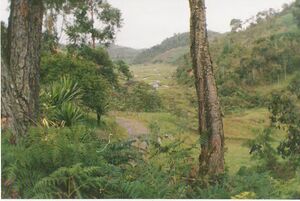Colombia community action

The aim of this page is to recognise, celebrate and encourage the self-empowerment of community agency networks (CANs) and community groups' activism for climate, environment and many other sustainability topics across Colombia.
 ‘The tranquility frees you’: Bogotá, the city that shuts out cars every week, theguardian.com (May 30, 2024)
‘The tranquility frees you’: Bogotá, the city that shuts out cars every week, theguardian.com (May 30, 2024)  This is how Latin America tries to turn its youth into young homeowners, globalvoices.org (Mar 01, 2024)
This is how Latin America tries to turn its youth into young homeowners, globalvoices.org (Mar 01, 2024)  Hopes for end to land conflicts raised by new agrarian courts in Colombia, news.mongabay.com (Feb 07, 2024)
Hopes for end to land conflicts raised by new agrarian courts in Colombia, news.mongabay.com (Feb 07, 2024)
Bioregionalism[edit | edit source]
- Regenerative Colombia, "People, bioregions and organizations co-creating conditions to regenerate life"
Biodiversity[edit | edit source]
Proyecto Tití Cotton-top Tamarin conservation program

Proyecto Titi is the name of an environmental program centered in Colombia with a special focus on the conservation of a critically endangered primate species endemic to the country, the Cotton-top Tamarin (Saguinus oedpipus). Due mainly to destruction of forest habitat and human colonization, the population of Cotton-top Tamarins has reached devastatingly low numbers in recent years. Proyecto Titi, which was founded in 1985, aims to bring awareness to the plight of the Cotton-top Tamarin through community education programs that focus on sustainability, as well as by encouraging field research studies that would hopefully allow us to better understand these secretive primates and protect the greater Colombian ecosystem as a whole.[1]
Biodiversity of Colombia
Colombia is one of the megadiverse countries in biodiversity, ranking first in bird species. Colombia is the country with the planet's highest biodiversity, having the highest rate of species by area as well as the largest number of endemisms (species that are not found naturally anywhere else) of any country. About 10% of the species of the Earth live in Colombia, including over 1,900 species of bird, more than in Europe and North America combined. Colombia has 10% of the world's mammals species, 14% of the amphibian species and 18% of the bird species of the world.
Open spaces[edit | edit source]
Protected areas and the "National Park System" cover an area of about 14,268,224 hectares (142,682.24 km2) and account for 12.77% of the Colombian territory. W
Trees, woodland and forest[edit | edit source]
The government of Colombia has launched the Amazon Vision Project. The Project, with the financial backing of Norway, Germany, and the United Kingdom, aims to completely eradicate deforestation of Colombia's Amazon by 2020. In the Climate Summit of 2015, Colombia, Germany, Norway, and the United Kingdom signed a Joint Declaration to strengthen collaboration on the climate and forests in Colombia. Norway has committed to a total of 1.8 billion Norwegian crones to Colombia within 2020. The project has been adopted as a national policy and priority in the new National Development Plan 2014-2018. The inclusion of the Program in this PND meant that for the first time in the country there is a framework for development policy that promotes green growth strategies with concrete goals of education of consequences of deforestation and goals of conservation and sustainable use for the Amazon region, offering the opportunity to influence national policies by inserting specificities of the Amazon region that help the region reduce deforestation. The project aims to improve forest governance, plan a sustainable sector development, begin environmental governance with indigenous people and enable conditions for the environment to thrive. W
Compared to neighboring countries, rates of deforestation in Colombia are still relatively low. Colombia had a 2018 Forest Landscape Integrity Index mean score of 8.26/10, ranking it 25th globally out of 172 countries. W
Cycling[edit | edit source]
Ciclovía
Ciclovía (, Spanish: [θikloˈβi.a]), also ciclovia or cyclovia, is a Spanish term that means "cycleway", either a permanent bike path or the temporary closing of certain streets to automobiles for cyclists and pedestrians, a practice sometimes called open streets.
The inspiration for Ciclovías is credited to Bogotá, Colombia. In 1970 the National Capital Commission in Canada's capital Ottawa organized open streets for active transportation. The events have taken place since December 1974 when they started through the efforts of organizer Jaime Ortiz Mariño and others cyclist aficionados. In 1976 Bogota's Mayor Luis Prieto Ocampo signed the 566 and 567 decrees and Ciclovía became an official program promoted by the City government and supported by the Transportation Department. In Bogotá, permanently designated bikeways are also known as ciclorrutas, while streets temporarily closed for that purpose are called ciclovías.
Each Sunday and public holiday from 7 am until 2 pm certain main streets of Bogotá, Cali, Medellín, and other cities are temporarily blocked off to cars allowing runners, skaters, and bicyclists to workout in a more comfortable environment. At the same time, stages are set up in city parks. Aerobics instructors, yoga teachers and musicians lead people through various performances. The great variety of traditional food and drinks offered in snack stalls motivates many locals and tourists to go around the Ciclovía. Bogotá's weekly ciclovías are used by approximately 2 million people (about 20% of the population) on over 120 km of car-free streets.
In 2007, a Colombian Congressman, José Fernando Castro Caycedo, proposed a law banning Ciclovia, charging that it caused traffic jams. Ciclovia users protested the change, and received support from ex-mayors Peñalosa and Samuel Moreno, as well as several members of the city council and other Members of Congress. The proposal was defeated.
The Bogota Ciclovía provides service from 7:00 am to 2:00 pm Sundays and holidays of the year by the main roads of the city, connected in a circuit of over 121 kilometers long and covers all sectors of the city.
This time space was born in 1974. Since 1995 its management was taken over by the IDRD. Since then and gradually, it has been constructed to reach its present appearance and acceptance among its thousands of users. Its infrastructure allows nearly one million (1,000,000) users leave their homes to safely practice different types of physical activities.
The Ciclovía was awarded under the II International Competition 2005 Active Cities Healthy Cities, through its contribution to the development of an alternative and efficient physical activity in the city. W
Sustainable transport[edit | edit source]
Urban transport
Urban transport systems have been developed in Barranquilla, Bogotá, Cali, and Medellín. Traffic congestion in Bogotá had been greatly exacerbated by a lack of rail transport; however, this problem was alleviated, to a degree, by the formation of one of the world's most expansive and highest-capacity bus rapid transit (BRT) systems—known as the TransMilenio (opened 2000)—and the restriction of vehicles through a daily, rotating ban on private cars (depending on plate numbers). Bogotá's BRT consists of bus and minibus services managed by both private- and public-sector enterprises.
Since 1995, Medellín has had a modern urban railway, the Metro de Medellín, utilizing two train lines with 27 stations. The Metro also connects with the cities of Itagüí, Envigado, and Bello. An elevated gondola-cablecar system, the Metrocable, opened in 2004 to improve Metro accessibility for some of the city's more isolated, dense barrios. The gondola design was specifically chosen due to the mountainous geography of the city, with most of the neighborhoods served being reasonably higher in elevation from the city center. A BRT line called Transmetro began operating in 2011, with a second line added in 2013.
Other Colombian cities have also installed BRT systems, such as Cali, with a six-line system (opened 2008), Barranquilla with two lines (opened 2010), Bucaramanga with one line (opened 2010), Cartagena with one line (opened 2015) and Pereira, with three lines (opened 2006). A future light rail line in Barranquilla is planned.
see also: Bogotá community action, Sustainable transport activism
Chiva bus
A chiva (Spanish for goat) or escalera (Spanish for ladder and stairs) is an artisan rustic bus used in rural Colombia and Ecuador. Chivas are adapted to rural public transport, especially considering the mountainous geography of the Andean region of these countries.
The buses are varied and characterized by being painted colorfully (usually with the yellow, blue, and red colors of the flags of Colombia, Venezuela and Ecuador) with local arabesques and figures. Most have a ladder to the rack on the roof which is also used for carrying people, livestock and merchandise.
They are built upon a bus chassis with a modified body made out either metal or wood. Seats are benchlike, made out of wood and with doors instead of windows. The owner or driver usually gives the vehicle a unique nickname.
Urban sustainability[edit | edit source]
About Colombia[edit | edit source]
Environmental issues in Colombia
Decades of civil war and political unrest has impeded biological and environmental research in Colombia. The political unrest in Colombia catalyzes the alteration of land patterns through the cultivation of coca and opium crops, the redirection of extractive activities, and land abandonment in some areas.
There are many environmental issues in Colombia. Issues include deforestation, soil erosion, illicit drug crops grown in national natural reserves by mafias (not peasants), pollution on major bodies of water by corporations (backed up by unregulated / unsupervised policies and by the corruption of local and federal authorities) among others.
There is soil and water quality damage from contamination by the use of chemicals in the coca-refining process, spillage of crude oil into the local rivers as a result of guerrilla sabotage of pipelines, overuse of pesticides, and air pollution (especially in Bogotá) from vehicle emissions. Natural hazards include highlands subject to volcanic eruptions, occasional earthquakes, and periodic droughts. W
Colombia, officially the Republic of Colombia, is a constitutional republic in northwestern South America. Colombia is bordered to the east by Venezuela and Brazil; to the south by Ecuador and Peru;to the north by the Caribbean Sea; to the northwest by Panama; to the west by the Pacific Ocean; and to the east by Venezuela. Colombia also shares maritime borders with Venezuela, Jamaica, Haiti, the Dominican Republic, Honduras, Nicaragua and Costa Rica.With a population of over 45 million people, Colombia has the 29th largest population in the world and the second largest in South America, after Brazil.The territory of what is now Colombia was originally inhabited by indigenous nations including the Muisca, Quimbaya, and Tairona.
Near you[edit | edit source]
References
- ↑ Proyecto Titi: Conserving the Cotton-top Tamarin
}}